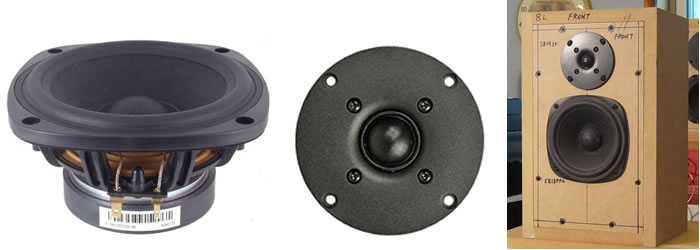|
Sparrow-19ST ver2
SB Acoustics SB13PFC25-08 with SB19ST-C000-4 Tweeter
Active Tri-Amped
I’ve been listening to the Sparrow-19ST for the past 5 months in an active 3-way configuration. While it is above average, I was still not too satisfied. I wanted to see whether I can elevate it to a higher level.
The first thing I did was to switch over to a 24dB/oct Linkwitz Riley electronic crossover. With a steeper slope, I lowered the crossover frequency to 2kHz. I don’t usually do this with a 3/4″ dome tweeter for fear of exciting the resonant frequency but I thought it’s worth a try. And I was right. Now, the Sparrow-19ST delivers what I am after – crystal clear, distinct vocals.
Frequency Response of SB19ST-C000-4 Tweeter
Fig 1 – Black Plot=RAW. Red Plot=2.0kHz @ 24dB/oct. Blue Plot=3.0kHz @ 18dB/oct
Fig 1 is the overlay of the various frequency responses of the SB19ST tweeter. The Black plot is the RAW response, that is without any crossover. The new response is the Red plot at 2kHz, 24dB/oct. Compare this with the original Sparrow-19ST tweeter roll-off at 3.0kHz @18dB/oc (Blue plot) and we can see why the mids sound so much better. There is a +10dB extra at 2kHz.
Crossing the SB13PFC25-08 with SB19ST-C000-4 Tweeter
fc = 2.0kHz • 24dB/oct Linkwitz Riley
Fig 2 – Blue plot=SB13PFC25-08. Red plot=SB19ST-C000-4
Fig 2 shows the SB13PFC25 and the SB19ST with my electronic crossover at 24dB/oct. The two drivers cross acoustically at about 1.7kHz. This is not the fault of the electronic crossover. The cause is the SB19ST has a +5dB hump below 2kHz. Had it been flat, the two drivers would have crossed at 2kHz acoustically.
On the left end of the Blue plot, we see the SB13PFC rolling off sharply below 200Hz. This is due to the High Pass filter of the crossover.
Sparrow-19ST ver2 with Bandpass Sub Frequency Response
Fig 3 – Crossover Frequencies at 250Hz and 2kHz.
Fig 3 shows the three individual reponses of the 3-way Sparrow-19ST ver2. The violet plot is that of a new 10″ bandpass sub that I’m testing out. In this instance, the crossover is at 250Hz but it can go down to 125Hz if desired.
Summed 3-way Response of Sparrow-19ST ver2
Fig 4 – Summed Response of Bandpass Sub with Sparrow-19ST ver2
Fig 4 is the summed response of the 3-way Sparrow-19ST ver2 with the Bandpass Sub included. Measurements below 500Hz are not very accurate as they include room reflections. However, it does show the Bandpass Sub extends the Sparrow-19ST satellite down to 40Hz.
In this Summed Response, the Bandpass Sub and the SB19ST tweeter are both wired in Reversed Phase. Only the SB13PFC is in absolute phase. All measurements are taken with mic at 1 meter, tweeter axis with Impulse Window at 5 microsec. No smoothing applied.
How’s does the Version 2 compare with the first Sparrow-19ST?
The difference is quite astounding. While the original 3-way Sparrow-19ST sounds decent enough, this Version 2 is outstanding. The music jumps to live. No one will believe it’s from cheapo drivers.
The male and female voices are now much more distinct, adding to the realism. There’s no veil in the vocals. Voices are as clear as can be and the treble is free of harshness.
The bass dynamics have improved tremendously too with this new 10″ Bandpass sub. It’s unfortunate that this sub is unobtainium because in it is a vintage 10″ Pyramid Gold Series Car Subwoofer that’s been with me for almost 20 years. I never got it to sound right until I decided to load it into a Bandpass enclosure.
In summary, this Version 2 is a very high quality sound system from budget drivers but it demands an active 3-way system. To run it passive at 24dB/oct would be exorbitant. The cost of the crossover components will exceed that of the drivers. But all is not lost. Active tri-amping need not be expensive. The SB13PFC and the 19ST tweeter can be powered by chip amps like the LM3886 of TDA7293. As for the bass, the Bandpass Sub needs more muscle, like a 150-200 Watts into 4 Ω amplifier.
I am so pleased with this version that I will use it as one of my reference systems.
|




